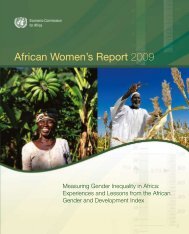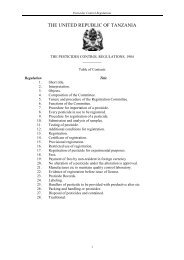Community-driven development decision tools for rural - IFAD
Community-driven development decision tools for rural - IFAD
Community-driven development decision tools for rural - IFAD
- No tags were found...
You also want an ePaper? Increase the reach of your titles
YUMPU automatically turns print PDFs into web optimized ePapers that Google loves.
allowing CBOs to handle cash advances is marginal, given the small amounts of cash involvedand the transparency of the community organizations. Further, the practice greatly facilitatesmobilizing local procurement, stimulates adopting local technologies that result in considerablylower costs of small infrastructure construction, accelerates disbursement of project funds, cutsthe risk of corruption inherent in large contracts and reduces the cost of project administration.These practices can only be followed if they are accepted government practices or if the borrowerand the management of the external financial agency agree.Project exit arrangementsProject exit arrangements represent an important “acid test” <strong>for</strong> a project’s CDD approach. At theend of a CDD project, a target number of CBOs should be able to identify their ownmicroproject ideas, mobilize support <strong>for</strong> designing them, collect local resources to financeimplementation, procure the necessary technical advice in the national market and implement,operate and maintain their own microproject. In most developing countries, where the districtadministration is still weak, the capacity that an advanced CDD project may wish to build at thecommunity level is not yet available at the district level.<strong>Community</strong>-level <strong>development</strong> activities are less complex than those at the district level andgenerally require much less know-how. Also, procedures at the community level are much easierto master than procedures designed <strong>for</strong> the higher level. This issue raises the need <strong>for</strong> having afriendly institutional environment, which was addressed in Chapter II.The chances of building community-level capacity depends on the extent to which the CBOshave participated in and been responsible <strong>for</strong> implementing their own projects and have learnedby doing and by making mistakes. Given the very limited cost of most community-level projects,the financial risk of allowing CBOs to handle cash advances is usually minimal compared withthe likely positive impact on developing the capability of the CBOs.It is legitimate to ask whether and under what conditions the desired exit arrangements can beeffectively established within the time horizon of a single project. At least three conditions arelikely to influence this:• whether the MCs of the CBOs have been involved in all the steps of the project and whetherthey have been adequately trained to manage small contracts, operate and maintain newlyconstructed facilities and effectively mobilize the resources required <strong>for</strong> O&M;• whether a sufficient number of people in the community have acquired the necessaryminimum training and experience. This would probably require that the project fund morethan one community-level project in each village, which is not always a practical option inthe short time horizon of a single project;• whether there are private service providers that can help the CBOs design projects requiringa minimum of technology and procure equipment that is available in the national marketbut not in the communities. In the middle-income countries of Asia and Latin America,there is no scarcity of private technicians who can be contracted by the CBOs. In poorestcountries, especially in Africa, this is a condition that generally takes time to develop.70
















